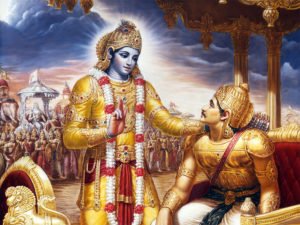Basic philosophy of ISKCON
The International Society for Krishna Consciousness (ISKCON), otherwise known as the Hare Krishna movement, includes five hundred major centers, temples and rural communities, nearly one hundred affiliated vegetarian restaurants, thousands of namahattas or local meeting groups, a wide variety of community projects, and millions of congregational members worldwide. Although less than fifty years on the global stage, ISKCON has expanded widely since its founding by His Divine Grace A. C. Bhaktivedanta Swami Prabhupāda in New York City in 1966.
ISKCON belongs to the Gaudiya-Vaishnava sampradāya, a monotheistic tradition within the Vedic or Hindu culture. Philosophically it is based on the Sanskrit texts Bhagavad-gītā and the Bhagavat Purana, or Srimad Bhagavatam. These are the historic texts of the devotional bhakti yoga tradition, which teaches that the ultimate goal for all living beings is to reawaken their love for God, or Lord Krishna, the “all-attractive one”.
God is known across the world by many names including Allah, Jehovah,Yahweh, Rama, etc. ISKCON devotees chant God’s names in the form of the maha-mantra, or the great prayer for deliverance:
Hare Krishna Hare Krishna, Krishna Krishna Hare Hare
Hare Rama Hare Rama Rama Rama Hare Hare.
Many leading academics have highlighted ISKCON’s authenticity. Diana Eck, Professor of Comparative Religion and Indian Studies at Harvard University, describes the movement as “a tradition that commands a respected place in the religious life of humankind.” In the 1980s Dr.A. L. Basham, one of the world’s authorities on Indian history and culture, wrote of ISKCON that, “It arose out of next to nothing in less than twenty years and has become known all over the West. This, I feel, is a sign of the times and an important fact in the history of the Western world.”
ISKCON’s founder, Srila Prabhupada, has drawn appreciation from scholars and religious leaders alike for his remarkable achievement in presenting India’s Vaishnava spiritual culture in a relevant manner to contemporary Western and worldwide audiences.
Members of ISKCON practice bhakti-yoga in their homes and also worship in temples. They also promote bhakti-yoga, or Krishna Consciousness, through festivals, the performing arts, yoga seminars, public chanting, and the distribution of the society’s literatures. ISKCON members have also opened hospitals, schools, colleges, eco-villages,free food distribution projects, and other institutions as a practical application of the path of devotional yoga.
- Anyone by sincerely cultivating true spiritual science, we can be free from anxiety and come to a state of pure, unending, blissful consciousness in this very lifetime.
- We are not our bodies but eternal, spirit souls, parts and parcels of supreme lord Sri Krishna. As such, we are all brothers, and Krishna is ultimately our common father. We accept the process of transmigration of the soul (reincarnation).
- Krishna is eternal, all-knowing, omnipresent, all-powerful, and all-attractive. He is the seed-giving father of all living beings, and He is the sustaining energy of the entire cosmic creation. He is the same God as The Father Allah, Buddha and Jehovah.
- The Absolute Truth is contained in the Vedas, the oldest scriptures in the world. The essence of the Vedas is found in the Bhagavad-gita, a literal record of Krishna’s words.
- One can learn the Vedic knowledge from a genuine spiritual master — one who has no selfish motives and whose mind is firmly fixed on Krishna.
- Before one eats, one offers to the Lord Krishna the food that sustains all humans; then Krishna becomes the offering and purifies the offered.
- One performs all actions as offerings to Krishna and does nothing for one’s own sense gratification.
- The recommended means for achieving the mature stage of love of God in this age of Kali, or quarrel, is to chant the holy names of the Lord. The easiest method for most people is to chant the Hare Krishna mantra:
Hare Krishna Hare Krishna Krishna Krishna Hare Hare.
Hare Rama Hare Rama Rama Rama Hare Hare.

